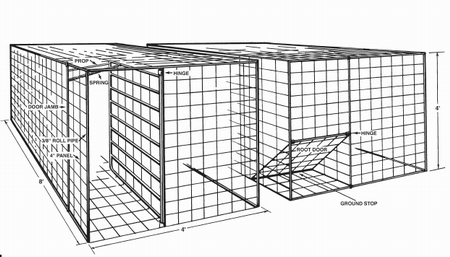Feral hog populations have the ability to grow and expand their range rapidly. Because feral hogs are so prolific, hunters and landowners must control hog populations through hog hunting and hog trapping. Although hunting can reduce hog numbers, hog trapping is the most effective technique for reducing local hog populations. Snares can be used to catch and kill wild and feral hogs, but live traps are preferred because caught hogs can be either consumed or sold. Below you will find the materials and directions necessary for designing and building an effective hog trap.
Hog Trap Materials
Feral hogs are smart, but they can be caught with a simple-made trap that almost anyone with some fabrication skills can make. Items you will need to make your hog trap include materials for the frame, such as 3/8″ or 1/4″ steel rod or rebar. In addition, you will need 4″ galvanized stock (cattle) panel and a heavy duty galvanized spring for a swing door. You may need a few other random items, but these materials are the bulk of what you will need to build your hog trap.

Directions for Building a Hog Trap
Weld all parts of frame to ensure strength and durability of the trap. After the frame is constructed, tack weld stock panels to frame on all sides, including bottom, to prevent hog from digging out. Take care not to leave any pointed ends of the cut panel sticking out. Construct spring or root door separately and install so that opening in front operates as illustrated.
The doors should be mounted on one side of the front panel and need to be at least 20-24″ wide and 18-24″ tall. For the spring doors, place a full length of 1/4″ rod just inside the side of the trap side to act as a stop (as illustrated). Take care to measure accurately during construction so that spring door when closed will hit trap side stop. Using a heavy-duty spring available at most hardware stores), place one end on the spring door and one end to the front of the cage at the top.
Cut the spring to fit so that it allows the spring door to slam shut securely. Do not use excessive tension on the spring that may prevent smaller hogs from entering. For root doors, the ground acts as the doorstop. The root door is hinged from the top and should be longer than the opening so it hits the ground inside the trap at about a 60- degree angle. A heavy piece of angle iron should be used as the bottom of the root door to make sure it stays on the ground but not too heavy to prevent smaller pigs from lifting it with their snout.
An angled piece of panel should be placed on the inside side to cover the hole that is left from the angled door while the side of the trap covers the other hole. With all of this done, your trap is built! This hog trap design has been proven effective time and time again, so start prebaiting your trap and get ready to catch some hogs!